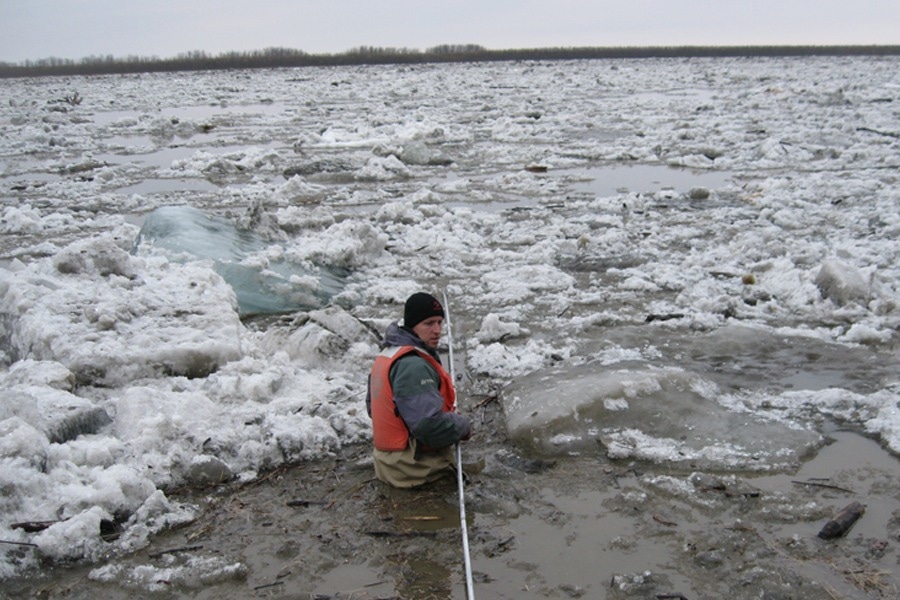Carbon cycling through the environment is an important part of life on Earth.
 Florida State University Professor Robert Spencer sampling the Yukon River at the Yupik village of Pilot Station, Alaska during the peak of the spring thaw. Image Credit: Robert Spencer.
Florida State University Professor Robert Spencer sampling the Yukon River at the Yupik village of Pilot Station, Alaska during the peak of the spring thaw. Image Credit: Robert Spencer.
Understanding the different carbon sources and reservoirs is a major goal of Earth science research as carbon is used by plants and animals for cellular growth. It can be found in rocks and minerals as well as in the ocean. Carbon, in the form of carbon dioxide, can enter the atmosphere and contribute to a warming planet.
Plants and small organisms in Arctic rivers may be responsible for more than half of the particulate organic matter flowing to the Arctic Ocean, according to research led by Florida State University researchers. This is a much higher proportion than was originally projected, and it has ramifications for how much carbon is sequestered in the ocean and how much enters the atmosphere.
For many years, researchers have analyzed the organic matter in rivers to better comprehend how carbon moves through watersheds. However, according to new research published in the Proceedings of the National Academy of Sciences, organisms in the Arctic’s major rivers contribute significantly to carbon export, accounting for 40 to 60% of particulate organic matter—tiny bits of decaying organisms—flowing into the ocean.
When people thought about these major Arctic rivers and many other rivers globally, they tended to think of them as sewers of the land, exporting the waste materials from primary production and decomposition on land.
Rob Spencer, Professor, Department of Earth, Ocean and Atmospheric Science, Florida State University
Spencer continues, "This study highlights that there’s a lot of life in these rivers themselves and that a lot of the organic material that is exported is coming from production in the rivers."
Carbon exported through waterways is being studied by researchers to gain further insight into the carbon cycle. As organic material decomposes on land, it can flow into rivers, which then drain into the ocean. Some of that carbon feeds marine life, while others sink to the ocean floor and become buried in sediments.
The scientists examined the six major rivers that flow into the Arctic Ocean: the Yukon and Mackenzie in North America, and the Ob’, Yenisey, Lena, and Kolyma in Russia. Models were developed that used the stable and radioactive isotope signatures of carbon, as well as the carbon-to-nitrogen ratios of particulate organic matter, to assess the contribution of potential sources to the chemistry of each river.
Not all organic particulate matter is made equal. Carbon drained downstream from soils is much more likely to be buried in the ocean than carbon produced within a river. The ocean carbon will be eaten by organisms and ultimately expelled as carbon dioxide.
It’s like the difference between a french fry and a stem of broccoli. That broccoli is going to stay in storage in your freezer, but the french fry is much more likely to get eaten.
Megan Behnke, Study Lead Author and Researcher, University of Alaska, Southeast
Megan Behnke is a former FSU doctoral student.
This means that a small increase in a river’s biomass might be equivalent to a greater increase in organic material originating on land. If the carbon in that organic matter is released into the atmosphere, the rate of carbon cycling and the related climate change in the Arctic will be affected.
I always get excited as a scientist or a researcher when we find new things, and this study found something new in the way that these big Arctic rivers work and how they export carbon to the ocean. We have to understand the modern carbon cycle if we’re really going to begin to understand and predict how it’s going to change. This is really relevant for the Arctic at the rate that it’s warming and due to the vast carbon stores that it holds.
Rob Spencer, Professor, Department of Earth, Ocean and Atmospheric Science, Florida State University
The research was a collaborative international effort involving scientists from 10 different institutions.
Behnke adds, “That pan-Arctic view of science is more important than ever. The changes that are occurring are far bigger than one institution in one country, and we need these longstanding collaborations. That’s critically important to continue.”
The co-authors are Suzanne E. Tank, University of Alberta; James W. McClelland, University of Texas; Robert M. Holmes and Anya Suslova, Woodwell Climate Research Center; Negar Haghipour and Timothy I. Eglinton, ETH Zurich; Peter A. Raymond, Yale University.
Alexander V. Zhulidov and Tatiana Gurtovaya, South Russia Centre for Preparation and Implementation of International Projects; Nikita Zimov and Sergey Zimov, Russian Academy of Sciences; Edda A. Mutter, Yukon River Inter-Tribal Watershed Council; and Edwin Amos, Western Arctic Research Centre also contributed to the study.
The study was funded by the National Science Foundation through grants for the Arctic Great Rivers Observatory.
Journal Reference:
Behnke, M. I., et al. (2023). Aquatic biomass is a major source to particulate organic matter export in large Arctic rivers. Proceedings of the National Academy of Sciences. doi.org/10.1073/pnas.2209883120.